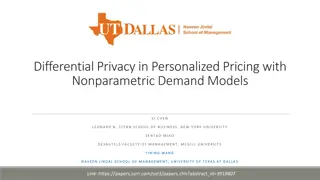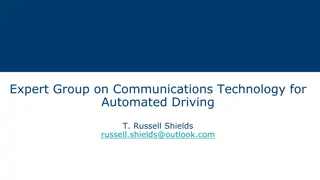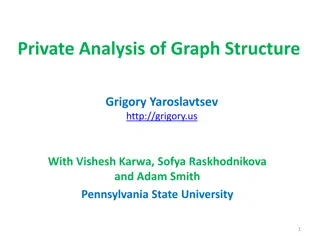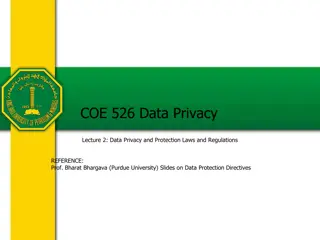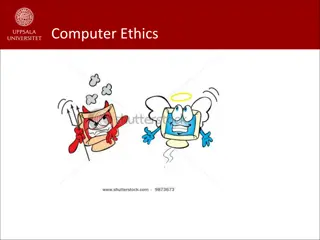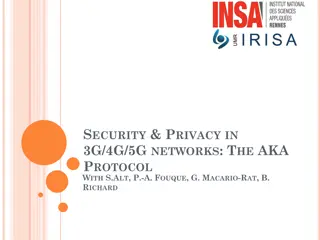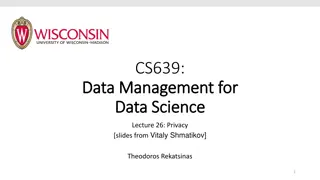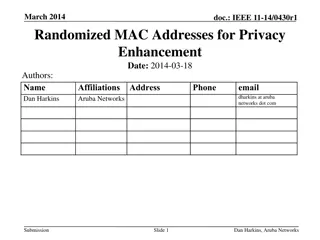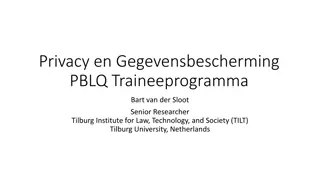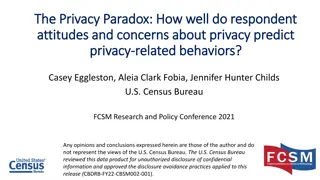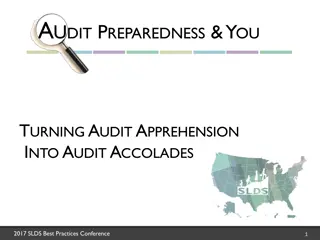Enhancing Privacy and Anonymous Communications with Technology
Explore the world of Privacy Enhancing Technologies (PETs) and Anonymous Communications through the work of George Danezis and his team at UCL. Dive into the challenges of network identity, lack of privacy, and weak identifiers in today's digital landscape. Learn about Ethernet and IP packet formats, and discover solutions to enhance privacy and security in online communications. Enroll in labs and leverage tools like petlib to manage tasks effectively.
Download Presentation

Please find below an Image/Link to download the presentation.
The content on the website is provided AS IS for your information and personal use only. It may not be sold, licensed, or shared on other websites without obtaining consent from the author. Download presentation by click this link. If you encounter any issues during the download, it is possible that the publisher has removed the file from their server.
E N D
Presentation Transcript
Privacy Enhancing Technologies Anonymous Communications. George Danezis (g.danezis@ucl.ac.uk) With help from: Luca Melis (luca.melis.14@ucl.ac.uk) Steve Dodier-Lazaro (s.dodier-lazaro.12@ucl.ac.uk)
Administration & Labs Enrol into the moodle for M067/GA17. Enrolment key pets . Information, slides & links State of the Labs. More documentation on petlib: http://petlib.readthedocs.org/en/latest/ A readme with command line help and hints and help: https://github.com/gdanezis/PET- Exercises/blob/master/Lab01Basics/Lab01Readme.txt Unit tests grouped by task to help you manage them. ( git pull will update your exercises directory in the VM) Labs: How are you doing?
Network identity today Neither privacy nor authenticity / integrity No anonymity Weak identifiers everywhere: IP, MAC Logging at all levels Login names / authentication PK certificates in clear No identification Weak identifiers easy to modulate Expensive / unreliable logs. IP / MAC address changes Open Wi-Fi access points Bot-nets Also: Location data leaked Application data leakage Partial solution Authentication Open issues: DoS and network level attacks
Ethernet packet format Anthony F. J. Levi - http://www.usc.edu/dept/engineering/eleceng/Adv_Network_Tech/Html/datacom/ No integrity or authenticity MAC Address
IP packet format 3.1. Internet Header Format A summary of the contents of the internet header follows: 0 1 2 3 0 1 2 3 4 5 6 7 8 9 0 1 2 3 4 5 6 7 8 9 0 1 2 3 4 5 6 7 8 9 0 1 +-+-+-+-+-+-+-+-+-+-+-+-+-+-+-+-+-+-+-+-+-+-+-+-+-+-+-+-+-+-+-+-+ |Version| IHL |Type of Service| Total Length | +-+-+-+-+-+-+-+-+-+-+-+-+-+-+-+-+-+-+-+-+-+-+-+-+-+-+-+-+-+-+-+-+ | Identification |Flags| Fragment Offset | +-+-+-+-+-+-+-+-+-+-+-+-+-+-+-+-+-+-+-+-+-+-+-+-+-+-+-+-+-+-+-+-+ | Time to Live | Protocol | Header Checksum | +-+-+-+-+-+-+-+-+-+-+-+-+-+-+-+-+-+-+-+-+-+-+-+-+-+-+-+-+-+-+-+-+ | Source Address | +-+-+-+-+-+-+-+-+-+-+-+-+-+-+-+-+-+-+-+-+-+-+-+-+-+-+-+-+-+-+-+-+ | Destination Address | +-+-+-+-+-+-+-+-+-+-+-+-+-+-+-+-+-+-+-+-+-+-+-+-+-+-+-+-+-+-+-+-+ | Options | Padding | +-+-+-+-+-+-+-+-+-+-+-+-+-+-+-+-+-+-+-+-+-+-+-+-+-+-+-+-+-+-+-+-+ Link different packets together Weak identifiers Example Internet Datagram Header Figure 4. No integrity / authenticity Same for TCP, SMTP, IRC, HTTP, ...
Anonymity in communications Specialized applications Electronic voting Auctions / bidding / stock market Incident reporting Witness protection / whistle blowing Showing anonymous credentials! General applications Freedom of speech Profiling / price discrimination Spam avoidance Investigation / market research Censorship resistance
Anonymity properties (1) Sender anonymity Alice sends a message to Bob. Bob cannot know who Alice is. Receiver anonymity Alice can send a message to Bob, but cannot find out who Bob is. Bi-directional anonymity Alice and Bob can talk to each other, but neither of them know the identity of the other.
Anonymity properties (2) 3rd party anonymity Alice and Bob converse and know each other, but no third party can find this out. Unobservability Alice and Bob take part in some communication, but no one can tell if they are transmitting or receiving messages. Unlinkability Two messages sent (received) by Alice (Bob) cannot be linked to the same sender (receiver). Pseudonymity All actions are linkable to a pseudonym, which is unlinkable to a principal (Alice)
High-Latency Anonymity Systems Mix Networks
Anonymity through Broadcast Point 1: Do not re-invent this E(Junk) Point 2: Many ways to do broadcast - Ring - Trees It has all been done (Buses) Simple receiver anonymity E(Message) Point 3: Is your anonymity system better than this? E(Junk) Point 4: What are the problems here? E(Junk) Coordination Sender anonymity Latency Bandwidth E(Junk)
Mix practical anonymity David Chaum (concept 1979 publish 1981) Reference is marker in anonymity bibliography Makes uses of cryptographic relays Break the link between sender and receiver Cost O(1) O(logN) messages O(1) O(logN) latency Security Computational (public key primitives must be secure) Threshold of honest participants
The mix illustrated A->M: {B, Msg}Mix M->B: Msg Alice Bob The Mix Adversary cannot see inside the Mix
The mix security issues 1) Bitwise unlinkability ? A->M: {B, Msg}Mix M->B: Msg Alice Bob The Mix ? 2) Traffic analysis resistance
Mix security (contd.) Bitwise unlinkability Ensure adversary cannot link messages in and out of the mix from their bit pattern Cryptographic problem Traffic analysis resistance Ensure the messages in and out of the mix cannot be linked using any meta- data (timing, ...) Two tools: delay , inject or drop traffic add cost!
Two broken mix designs (1) Broken bitwise unlinkability The `stream cipher mix (Design 1) {M}Mix = {fresh k}PKmix, M Streamk Stream Cipher Message , k k PKMix Active attack? A->M: {B, Msg}Mix M->B: Msg Alice Bob Tagging Attack The Mix Adversary intercepts {B, Msg}Mix and injects {B, Msg}Mix (0,Y). The mix outputs message: M->B: Msg Y And the attacker can link them.
Lessons from broken design 1 Mix acts as a service Everyone can send messages to it; it will apply an algorithm and output the result. That includes the attacker decryption oracle, routing oracle, ... (Active) Tagging attacks Defence 1: detect modifications (CCA2) Defence 2: destroy all information (Mixminion, Minx)
GA17 Lab 2 Implement a simple mix client Note: the second lab will be on implementing a simple mix client, and fixing aspects of a mix server.
Insight into a Modern message format Input Input Processing Processing inside inside MIx MIx Output Output George Danezis & Ian Goldberg. Sphinx: A Compact and Provably Secure Mix Format. IEEE S&P 09.
Two broken mix designs (2) Broken traffic analysis resistance The `FIFO* mix (Design 2) Mix sends messages out in the order they came in! Passive attack? A->M: {B, Msg}Mix M->B: Msg Alice Bo b The adversary simply counts the number of messages, and assigns to each input the corresponding output. The Mix * FIFO = First in, First out
Lessons from broken design 2 Mix strategies mix messages together Threshold mix: wait for N messages and output them in a random order. Pool mix: Pool of n messages; wait for N inputs; output N out of N+n; keep remaining n in pool. Timed, random delay, ... Threshold Mix Pool Mix Pool Hell is other people J.P. Sartre Anonymity security relies on others Problem 1: Mix must be honest Problem 2: Other honest sender-receiver pairs to hide amongst
Distributing mixing Rely on more mixes good idea Distributing trust some could be dishonest Distributing load fewer messages per mix Two extremes Mix Cascades All messages are routed through a preset mix sequence Good for anonymity poor load balancing Free routing Each message is routed through a random sequence of mixes Security parameter: L then length of the sequence
The free route example A->M2: {M4, {M1,{B, Msg}M1}M4}M2 Free route mix network The Mix Alice Bob M 1 M M3 2 M (The adversary should get no more information than before!) 4 M5 M6 M7
Free route mix networks Bitwise unlinkability Length invariance Replay prevention How to find mixes? Lists need to be authoritative, comprehensive & common Additional requirements corrupt mixes Hide the total length of the route Hide the step number (From the mix itself!) Length of paths? Good mixing in O(log(|Mix|)) steps = log(|Mix|) cost Cascades: O(|Mix|) We can manage Problem 1 trusting a mix
Problem 2 who are the others? The (n-1) attack active attack Wait or flush the mix. Block all incoming messages (trickle) and injects own messages (flood) until Alice s message is out. 1 Alice Bob The Mix n Attacker
Mitigating the (n-1) attack Strong identification to ensure distinct identities Problem: user adoption Message expiry Messages are discarded after a deadline Prevents the adversary from flushing the mix, and injecting messages unnoticed Heartbeat traffic Mixes route messages in a loop back to themselves Detect whether an adversary is blocking messages Forces adversary to subvert everyone, all the time General instance of the Sybil Attack
Robustness to Denial of Service (DoS) Malicious mixes may be dropping messages Special problem in elections Original idea: receipts (unworkable) Two key strategies to prevent DoS Provable shuffles will not cover here. Randomized partial checking
Randomized partial checking Applicable to any mix system Two round protocol Mix commits to inputs and outputs Gets challenge Reveals half of correspondences at random Everyone checks correctness Pair mixes to ensure messages get some anonymity
Partial checking illustrated Mix i Mix i+1 Reveal half Reveal other half Slight lie Rogue mix can cheat with probability at most Messages are anonymous with overwhelming probability in the length L Even if no pairing is used safe for L = O(logN)
Receiver anonymity Cryptographic reply address Alice sends to bob: M1,{M2, k1,{A,{K}A}M2}M1 Memory-less: k1 = H(K, 1) k2 = H(K, 2) Bob replies: B->M1: {M2, k1, {A,{K}A}M2}M1, Msg M1->M2: {A,{K}A}M2 , {Msg}k1 M2->A: {K}A, {{Msg}k1}k2 Security: indistinguishable from other messages
Basic Traffic Analysis Anonymity is more fragile than communications privacy!
Fundamental limits What is traffic analysis: The discipline of inferring information from patterns of traffic. Applied to security: assume content is encrypted; traffic is anonymized: Traffic analysis of hardened targets Even perfect anonymity systems leak information when participants change Setting: N senders / receivers Alice is one of them Alice messages a small number of friends: RA in {Bob, Charlie, Debbie} Through a MIX / DC-net Perfect anonymity of size K Can we infer Alice s friends?
Setting rA in RA= {Bob, Charlie, Debbie} Alice K-1 Senders out of N-1 others K-1 Receivers out of N others Anonymity System (Model as random receivers) Alice sends a single message to one of her friends Anonymity set size = K Entropy metric EA = log K Perfect!
Many rounds Alice rA1 Observe many rounds in which Alice participates T1 Anonymity System Others Others Rounds in which Alice participates will output a message to her friends! Alice rA2 T2 Anonymity System Others Others Infer the set of friends! Alice rA3 T3 Anonymity System Others Others Alice rA4 T4 Anonymity System Others Others ... Tt
Hitting set attack (1) Guess the set of friends of Alice (RA ) Constraint |RA | = m Accept if an element is in the output of each round Downside: Cost N receivers, m size (N choose m) options Exponential Bad Good approximations...
Statistical disclosure attack Note that the friends of Alice will be in the sets more often than random receivers How often? Expected number of messages per receiver: other= (1 / N) (K-1) t Alice= (1 / m) t + other Just count the number of messages per receiver when Alice is sending! Alice > other
Comparison: HS and SDA Parameters: N=20 m=3 K=5 t=45 KA={[0, 13, 19]} Round Receivers 1 [15, 13, 14, 5, 9] [13, 14, 15] SDA 2 SDA_error #Hitting sets 685 2 [19, 10, 17, 13, 8] [13, 17, 19] 1 395 3 [0, 7, 0, 13, 5] [0, 5, 13] 1 257 4 [16, 18, 6, 13, 10] [5, 10, 13] 2 203 Round 16: 5 [1, 17, 1, 13, 6] [10, 13, 17] 2 179 6 [18, 15, 17, 13, 17] [13, 17, 18] 2 175 Both attacks give correct result 7 [0, 13, 11, 8, 4] [0, 13, 17] 1 171 8 [15, 18, 0, 8, 12] [0, 13, 17] 1 80 9 [15, 18, 15, 19, 14] [13, 15, 18] 2 41 10 [0, 12, 4, 2, 8] [0, 13, 15] 1 16 11 [9, 13, 14, 19, 15] [0, 13, 15] 1 16 12 [13, 6, 2, 16, 0] [0, 13, 15] 1 16 13 [1, 0, 3, 5, 1] [0, 13, 15] 1 4 14 [17, 10, 14, 11, 19] [0, 13, 15] 1 2 SDA: Can give wrong results need more evidence 15 [12, 14, 17, 13, 0] 16 [0, 13, 17] 1 2 [18, 19, 19, 8, 11] [0, 13, 19] 0 1 17 [4, 1, 19, 0, 19] [0, 13, 19] 0 1 18 [0, 6, 1, 18, 3] [0, 13, 19] 0 1 19 [5, 1, 14, 0, 5] [0, 13, 19] 0 1 20 [17, 18, 2, 4, 13] [0, 13, 19] 0 1 21 [8, 10, 1, 18, 13] [0, 13, 19] 0 1 22 [14, 4, 13, 12, 4] [0, 13, 19] 0 1
HS and SDA (continued) 25 [19, 4, 13, 15, 0] [0, 13, 19] 0 1 26 [13, 0, 17, 13, 12] [0, 13, 19] 0 1 27 [11, 13, 18, 15, 14] [0, 13, 18] 1 1 28 [19, 14, 2, 18, 4] [0, 13, 18] 1 1 29 [13, 14, 12, 0, 2] [0, 13, 18] 1 1 SDA: Can give wrong results need more evidence 30 [15, 19, 0, 12, 0] [0, 13, 19] 0 1 31 [17, 18, 6, 15, 13] [0, 13, 18] 1 1 32 [10, 9, 15, 7, 13] [0, 13, 18] 1 1 33 [19, 9, 7, 4, 6] [0, 13, 19] 0 1 34 [19, 15, 6, 15, 13] [0, 13, 19] 0 1 35 [8, 19, 14, 13, 18] [0, 13, 19] 0 1 36 [15, 4, 7, 13, 13] [0, 13, 19] 0 1 37 [3, 4, 16, 13, 4] [0, 13, 19] 0 1 38 [15, 13, 19, 15, 12] [0, 13, 19] 0 1 39 [2, 0, 0, 17, 0] [0, 13, 19] 0 1 40 [6, 17, 9, 4, 13] [0, 13, 19] 0 1 41 [8, 17, 13, 0, 17] [0, 13, 19] 0 1 42 [7, 15, 7, 19, 14] [0, 13, 19] 0 1 43 [13, 0, 17, 3, 16] [0, 13, 19] 0 1 44 [7, 3, 16, 19, 5] [0, 13, 19] 0 1 45 [13, 0, 16, 13, 6] [0, 13, 19] 0 1
Disclosure attack family Counter-intuitive The larger N the easiest the attack Hitting-set attacks More accurate, need less information Slower to implement Sensitive to Model E.g. Alice sends dummy messages with probability p. Statistical disclosure attacks Need more data Very efficient to implement (vectorised) Faster partial results Can be extended to more complex models (pool mix, replies, ...) The Future: Bayesian modelling of the problem
Summary of key points Near-perfect anonymity is not perfect enough! High level patterns cannot be hidden for ever Unobservability / maximal anonymity set size needed Flavours of attacks Very exact attacks expensive to compute Model inexact anyway Statistical variants wire fast!
Low Latency Anonymity Systems Tor, and all that
Onion Routing Anonymising streams of messages Example: Tor (The onion router) As for mix networks Alice chooses a (short) path Relays a bi-directional stream of traffic to Bob Cells of traffic Alice Bob Onion Router Onion Router Onion Router Bi-directional
Onion Routing vs. Mixing Setup route once per connection Use it for many cells save on public key operations No time for delaying Usable web latency 1 2 sec round trip Short routes Tor default 3 hops No batching (no threshold , ...) Passive attacks!
Stream Tracing Adversary observes all inputs and outputs of an onion router Objective: link the ingoing and outgoing connections (to trace from Alice to Bob) Key insight: timing of packets are correlated Two techniques: Correlation Template matching
Tracing (1) Correlation Onion Router 1 3 2 1 2 2 1 2 3 0 3 2 INi OUTi T=0 T=0 Number of cell per time interval Bucket input and output packets over time bins. Normalize around zero. Compute: Corr = i INi OUTi Downside: lose precision by bucketing.
Tracing (2) Template matching Input Stream Output Stream Onion Router INTemplate Compare with template vi Use input and delay curve to make template Prediction of what the output will be Assign to each output cell the template value (vi) for its output time Multiply them together to get a score ( ivi)
The security of Onion Routing Cannot withstand a global passive adversary (Tracing attacks too expensive to foil) Partial adversary Can see some of the network Can control some of the nodes Secure if adversary cannot see first and last node of the connection If c is fraction of corrupt servers Compromise probability = O(c2) No point making routes too long
Extending the route in Tor Alice OR1 OR2 OR3 Bob Authenticated DH Alice OR1 K1 Authenticated DH, Alice OR2 Encrypted with K1 Authenticated DH, Alice OR3 Encrypted with K1, K2 K2 K3 TCP Connection with Bob, Encrypted with K1, K2, K3
Some remarks Encryption of input and output streams under different keys provides bitwise unlinkability As for mix networks Is it really necessary? Authenticated Diffie-Hellman One-sided authentication: Alice remains anonymous Alice needs to know the signature keys of the Onion Routers Scalability issue 1000 routers x 2048 bit keys Advantage: Perfect Forward Secrecy!
Summary of key concepts on Anonymity Anonymity requires a crowd Difficult to ensure it is not simulated (n-1) attack Making one on your own expensive (broadcast) Mix networks Practical anonymous messaging Bitwise unlinkability / traffic analysis resistance Crypto: Decryption vs. Re-encryption mixes Distribution: Cascades vs. Free route networks Robustness: Partial checking Onion Routing Supports interactive streams Only withstands a partial adversary. Very widely deployed (Tor: The onion router)



